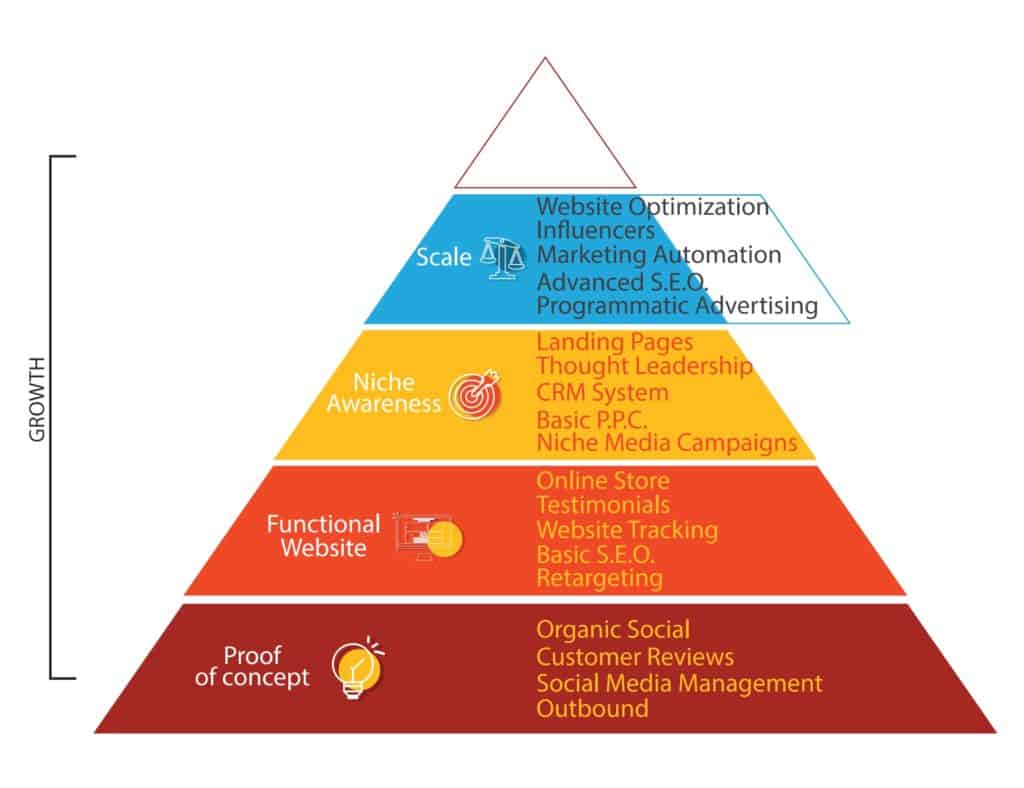eCommerce Marketing Hierarchy of Needs: Part Four

Readers have been clamoring for the fourth installment of eBridge’s ‘eCommerce Marketing Hierarchy of Needs’. If you haven’t yet read the first, second, or third posts in this series, you’re highly encouraged to-do-so! The first three posts helped to identify marketing priorities for organizations as they prove their business concept, make their first moves into eCommerce, and specialize in a niche market. This fourth installment focuses on priorities for companies who are looking to scale the success they’ve achieved with a niche, either by going after new markets, or penetrating their niche to a greater extent.
For each tier in the eCommerce Hierarchy of Needs, we look at marketing from the perspective of five important facets:
- Customer Experience: How customers interact with your brand and complete purchases.
- Reputation: How customers learn your brand is legitimate.
- MarTech: How technology aids your marketing efforts.
- Search Marketing: How to utilize search to find customers.
- Paid Advertising: How to best spend your ad budget.
Tier 4: Scale
Customer Experience: Website Optimization
How many steps does it take for a customer to maker a purchase or to complete your desired call-to-action? Is there any unnecessary info you’re asking for? Are you taking steps to capture the contact details for visitors who aren’t ready to purchase or engage yet? What steps can you take to improve the conversion process related to the UX? Asking questions like these and looking for little things to improve upon will have a significant cumulative effect on your conversion rate. A big component of website optimization is A/B testing. This is the process of iterating marketing creatives, letting the iterations run in the wild, recording the results, and keeping the favorable iterations. Rinse and repeat. There’s no doubt A/B testing is a powerful tool. But it can be a time consuming endeavor to do properly, and you need to have decent existing traffic levels in order to conduct statistically significant tests.
Reputation: Influencers
For B2C marketing, there’s a big trend towards brands supporting social media influencers. This is very common place in the cosmetics industry, where self-labelled Beauty gurus receive millions of views for YouTube videos of them applying make-up that’s been sent to them for free. Another great example of this is Samsung, who sponsored a popular YouTuber’s trip to a trampoline gymnasium; a Samsung phone was used to film the adventure, and the gymnasium environment lent itself to exhibiting the phone’s durability. The video received tens of millions of views.
MarTech: Marketing Automation
If you’ve already established the basics in terms of email marketing and social media, the next step is automating the process using intelligence to further qualify your lists and leads. Marketing automation helps save time and makes it easier to scale these tactics as your company grows, especially for companies without large marketing departments.
Search Marketing: Advanced S.E.O.
Most marketers find that they achieve a better conversion rate from organic traffic than any other channel. Thus the appeal of taking the next step with SEO efforts. Once the basics are covered off, it becomes difficult to make big gains in rank. Truthfully there’s only so much on-site SEO you can do before there are diminishing returns. Advanced SEO is characterized by off-site strategies like link building, putting out a ton of relevant content including important keywords and phrases, and tapping subject matter experts.
Paid Advertising: Programmatic Advertising
Programmatic advertising is essentially a bunch of algorithms bidding against each other for website traffic. You select among pre-defined filters to narrow down who will see your ads, set how much you’re willing to pay, and the algorithm will start bidding on your behalf. Some algorithms will incorporate look-alike targeting, meaning they will try to serve ads to people whose characteristics are similar to people who’ve completed purchases on your site. Programmatic advertising is a good choice for companies wishing to scale because it is very cost effective on a CPM-basis and there’s practically unlimited ad inventory available. However the minimum spends can be prohibitively high for some companies (typically tens of thousands per month).
Thanks for catching the fourth edition of eBridge’s Hierarchy of Needs. The upcoming final installment will discuss marketing tactics towards the goal of achieving a well-known brand.
Questions, feedback, or corrections? We’d love to hear from you!
Posted July 5, 2018
Categories: Hierarchy of Needs,
Advertising and Marketing General
Tags: Advertising, Content Creation, SEO, Social Media, Web Design

